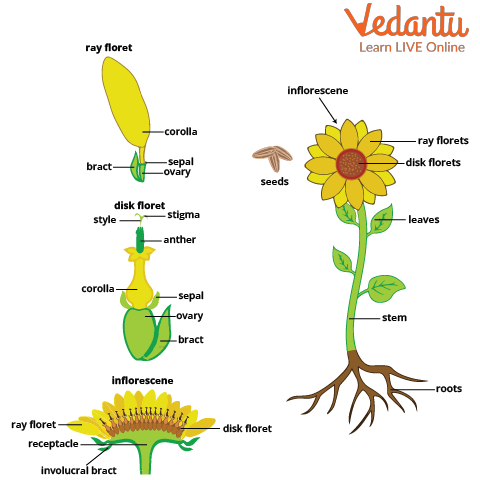Why Is Helianthus annuus Important in Biology?
After soybean, sunflower is a significant oil seed crop. It contains between 46 and 52 percent oil. USSR, Bulgaria, Canada, and the United States are the top nations for sunflower cultivation. This crop was introduced to India in 1969 from the USSR. Sunflowers are perennial herbs. Perennial plants, which persist for two years or more, are often found in South America and portions of Central America. The genus Helianthus contains several different composite plants, including sunflowers. It has oil seeds, so this is used as a cash crop.
What is a Sunflower?
A sunflower is an oil-yielding plant. Since sunflowers are planted for decorative purposes, they are referred to as "surajmukhi." After soybean, rapeseed, and mustard, it is the world's third largest oilseed crop in India.
It grows in sunny areas and short duration crops. Its solitary stem and enormous flowers set it apart from all other cultivated plants. The capitulum is the inflorescence. It has a flower that is bisexual. Its nature is protandrous. Early in the morning (6–10 am) is when flowering begins. The pollen grain's 12-hour vitality. The stigma's susceptibility might last for 2–3 days.
In the sunflower growth cycle, during which the initial couple of leaves are in opposition to one another, as the plant grows new leaves, they are positioned along the stem in an alternate pattern and 2 to 3 leaves appear each week. Initially, the leaf grows in the opposite direction and then starts growing alternatively, with the growth in the plant.

A Sunflower
Sunflower Scientific Name
The scientific name of sunflowers is Helianthus annuus. The classification of sunflower is given below:
Division: Phanerogams
Class: Dictoyledanae
Sub Class: Gamopetalae
Order: Asterase
Family: Asteraceae
Genus: Helianthus
Species: Annuus
Family of Sunflower
The sunflower species belong to the asteraceae family. The Asteraceae are the most numerous flowering plant families. The plants in this family have an inflorescence capitulum. The capitulum is flat in sunflowers. Flowers are known as florets. Florets are sessile, tubular, or ligulate. Disc and ray florets are present in Helianthus annus. The plants in this family have cypsela type fruit. Plants of this family are used as oils, perfumes, dyes, rubber, and also as ornamental plants.
Sunflower Species
It includes species that are diploid, tetraploid, and hexaploid. More than 67 species of Helianthus exist, of which two are domesticated. Helianthus annuus (sunflower, diploid, 2n=34) is grown for oilseed. Helianthus tuberosus (hexaploid, 2n = 104) is cultivated for its tubers. Shweinitz’s sunflower (Helianthus schweinitzii) is the rarest species of sunflower.
Different Types of Sunflower
There are too many types of sunflowers that are grown in field parks. There are different types of sunflowers on the basis of their height and colour. There are some plants that are tall and some that are dwarf, while some differ in colour.
Tall Plants
Some plants reach a height of around 12 feet, and some are hybrids, while some are native plants. The giant forms are 6 to 14 feet tall. These plants show late development, have large seeds with white, grey, or black striped heads, and are 12 to 30" in diametre. Very little oil is present. Some of the examples include Mammoth Russian, American giant sunflower, Shweinitz’s sunflower, etc.
Shweinitz’s Sunflower (Helianthus Schweinitzii)
It is an American sunflower species and its height is around 16-17 feet. These are light, bright yellow coloured flowers.
American Giant Sunflower (Helianthus Snnuus ‘American Giant‘)
It is a hybrid plant and grows in some harder climatic conditions, such as fast wind.
Skyscraper Sunflower (Helianthus Annuus ‘Skyscraper‘)
Its name implies that it is a sky touching plant. It has a thick and durable stalk in the wind.
Mammoth Russian Sunflower (Helianthus Annuus ‘Russian Mammoth‘)
It is the tallest and oldest type of sunflower. This type has thick and stable stems. Their seeds are used by some organisms, such as squirrels in the winter season.
Dwarf plants are grown in gardens and are considered as indoor plants.
Pacino Sunflower (Helianthus Annuus ‘Pacino Cola’)
Firecracker Sunflower (Helianthus Annuus ‘Firecracker’)
Coloured Sunflowers
Earthwalker sunflower, Terracotta sunflower, and Moulin Rouge sunflower (because of their vibrant burgundy crimson petals and continuous colour; sunflowers with these colours are among the most unusual.)
Ruby Eclipse Sunflower

Different Types of Sunflowers
Sunflower Plantation
The states of North Punjab, Haryana, Western Gujarat, Southern Andhra Pradesh, Tamil Nadu, and Karnataka are included in the cultivation zone. Both a double crop and a full-season crop of sunflower may be raised. As a double crop, it is particularly appealing from an economic perspective.
The crop needs a chilly temperature for seed germination and growth, while warm, sunny weather is needed for flowering. Since it is a photo-insensitive crop, it may be cultivated year-round. These plants can tolerate a variety of soil pH levels. From 5.7 to 8.0 is the pH range that sunflowers can withstand. Sunflowers may be grown in fields used for row crops.
Seeding depth for dense soils should be one to five inches. Sunflowers require a high seeding rate of 17,000 seeds per acre. Plantings in April or May often provide a larger yield than those in June or July. Need for temperature: If the seed is of excellent quality, sunflowers may sprout and emerge from soils as chilly as 46 oF. A mature sunflower can endure temperatures as low as 25 oF. The ideal range of daily mean temperatures for growth is between 18 and 25 oC. The width of the row has been better between 20 and 30 inches, but widths as wide as 40 inches and as narrow as 14 inches have produced good yields.
Conclusion
The sunflower’s botanical name is Helianthus annuus. Sunflowers are typically tall annual or perennial plants that can reach heights of 300 cm (120 in) or higher in some varieties. Sunflower is a group of flowers, not a single flower. What looks to be a single flower is actually an inflorescence, which is a collection of tiny blooms. These flowers are artistically arranged in a container. The term "capitulum" refers to this kind of inflorescence.


FAQs on Sunflower Scientific Name: Helianthus annuus
1. What is the scientific name of the common sunflower?
The scientific name for the common sunflower is Helianthus annuus. This name is part of the binomial nomenclature system, which gives a unique two-part name to every species. The first part, Helianthus, represents the genus, and the second part, annuus, represents the specific species.
2. What is the full taxonomic classification of a sunflower?
The complete taxonomic classification of the sunflower places it within the plant kingdom, providing a detailed biological address. The hierarchy is as follows:
- Kingdom: Plantae (Plants)
- Clade: Angiosperms (Flowering plants)
- Clade: Eudicots
- Order: Asterales
- Family: Asteraceae (the daisy or aster family)
- Genus: Helianthus
- Species: H. annuus
3. Why is the sunflower named Helianthus annuus?
The name Helianthus annuus is derived from Greek and Latin words that describe the plant's most notable characteristics.
- Helianthus combines the Greek words 'helios' (sun) and 'anthos' (flower), referring to the flower head's sun-like appearance and its tracking of the sun.
- Annuus is a Latin word meaning "annual," which correctly describes the plant's life cycle of growing, flowering, and producing seed within a single year.
4. What are the key characteristics of the Asteraceae family, to which the sunflower belongs?
The Asteraceae family, or daisy family, is defined by a unique floral structure called a 'capitulum' or composite flower head. What appears to be a single large flower is actually a dense cluster of many small individual flowers called florets. In a sunflower, this is seen as the central disc florets (which become seeds) and the surrounding ray florets (which look like petals).
5. Why do sunflower plants require so much water to grow effectively?
Sunflowers have a high water requirement due to their large size, broad leaves, and rapid growth in sunny conditions. The large leaf surface area leads to a high rate of transpiration (water loss via evaporation). To offset this loss, support their tall stalks, and develop oil-rich seeds, they must absorb a significant amount of water from the soil throughout their growing season.
6. What is the economic importance of the sunflower?
The sunflower is a globally important cash crop. Its primary economic value comes from its seeds, which are processed to produce a versatile cooking oil. Beyond oil, the seeds are eaten as nutritious snacks and used in bird feed. The leftover meal after oil extraction serves as a high-protein feed for livestock, making nearly every part of the harvest commercially valuable.
7. What makes sunflower seeds a healthy food choice?
Sunflower seeds are considered a nutrient-dense food. They are an excellent source of healthy unsaturated fats (like linoleic acid), high-quality protein, dietary fibre, and essential minerals including magnesium, selenium, and zinc. Furthermore, they are rich in Vitamin E, a powerful antioxidant that helps protect the body's cells from oxidative damage.
8. Do different types of sunflowers, like red ones, have different scientific names?
Generally, no. Most ornamental sunflower varieties, including those with red, orange, or bi-coloured petals, are cultivars of the same species, Helianthus annuus. These different appearances are the result of selective breeding within that single species. While the Helianthus genus contains over 50 distinct species (like Helianthus tuberosus, the Jerusalem artichoke), the vast majority of agricultural and garden sunflowers fall under H. annuus.
9. What is the difference between the scientific names for a sunflower plant and a sunflower sea star?
The sunflower plant and sunflower sea star are entirely unrelated organisms, which is clear from their scientific names.
- The sunflower plant's scientific name is Helianthus annuus. It belongs to the Plant Kingdom.
- The sunflower sea star's scientific name is Pycnopodia helianthoides. It belongs to the Animal Kingdom.
10. What is heliotropism in sunflowers and how does it actually work?
Heliotropism is the directional movement of a plant in response to the sun. Young sunflowers exhibit this by facing east at dawn and tracking the sun to the west by dusk. This is not a simple reaction to light but is driven by an internal circadian rhythm that causes one side of the stem to grow faster than the other at different times of the day. Once mature, the sunflowers typically stop this movement and remain facing east to warm up quickly and attract more morning pollinators.










